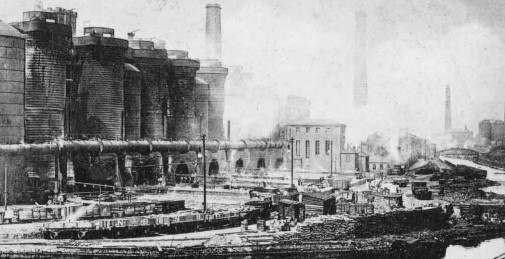Summerlee Iron Works on:
[Wikipedia]
[Google]
[Amazon]
 The Summerlee Iron Works (1836–1930) was an
The Summerlee Iron Works (1836–1930) was an
 The Summerlee Iron Works (1836–1930) was an
The Summerlee Iron Works (1836–1930) was an iron works
An ironworks or iron works is an industrial plant where iron is smelted and where heavy iron and steel products are made. The term is both singular and plural, i.e. the singular of ''ironworks'' is ''ironworks''.
Ironworks succeeded bloomeri ...
established in Coatbridge
Coatbridge ( sco, Cotbrig or Coatbrig, gd, Drochaid a' Chòta) is a town in North Lanarkshire, Scotland, about east of Glasgow city centre, set in the central Lowlands. Along with neighbouring town Airdrie, Coatbridge forms the area known as ...
, Scotland
Scotland (, ) is a country that is part of the United Kingdom. Covering the northern third of the island of Great Britain, mainland Scotland has a border with England to the southeast and is otherwise surrounded by the Atlantic Ocean to the ...
. The site has been incorporated into the Summerlee, Museum of Scottish Industrial Life
Summerlee Museum of Scottish Industrial Life is an industrial and social history museum in Coatbridge, North Lanarkshire, Scotland. It is situated on the site of the Victorian Summerlee Iron Works and the former Hydrocon Crane factory. The m ...
.
History
The Summerlee Iron Works was an early adopter of the ' Hot Blast Process', recently patented byJames Beaumont Neilson
James Beaumont Neilson (22 June 1792 – 18 January 1865) was a Scotland, Scottish inventor whose hot blast, hot-blast process greatly increased the efficiency of smelting iron.
Life
He was the son of the engineer Walter Neilson, a millwri ...
in 1828. This process burned waste furnace gases in regenerative stoves, to heat up a lattice of fire bricks inside them. Once the bricks were sufficiently heated, the waste furnace gases were purged and replaced by fresh air intended to fire the furnaces. The fire bricks transferred their heat to this air, turning it into the 'hot blast' pumped into the furnaces.
No traces of the original small rectangular stoves remain, but foundations of the round Cowper Stoves, that were as tall as the furnaces themselves (20 m) and installed in the 1870s, are visible.
The iron works closed in the early 1930s during the Great Depression
The Great Depression (19291939) was an economic shock that impacted most countries across the world. It was a period of economic depression that became evident after a major fall in stock prices in the United States. The economic contagio ...
and was demolished in 1938. Additional demolition took place in the 1950s during the construction of the Hydrocon crane factory.
Excavation
The site was excavated between 1985–1987 by theManpower Services Commission
The Manpower Services Commission (MSC) was a non-departmental public body of the Department of Employment Group in the United Kingdom created by Edward Heath's Conservative Government in 1973. The MSC had a remit to co-ordinate employment and tr ...
and again in 2000 by Glasgow University Archaeological Research Division. Four furnace hearths were excavated and are, together with the furnace bank wall, the most notable remains of the iron works.
Notes
References
* * 1836 establishments in Scotland 1930 disestablishments in Scotland Ironworks and steelworks in Scotland Defunct iron and steel mills {{Scotland-struct-stub